I made a knife case for my mushroom knife. I show the result first because I know many don't have the patience to look at the process and prefer instant gratification/disappointment. I haven't worked with leather for a long time. My stitching isn't up to par in looks but should be durable.
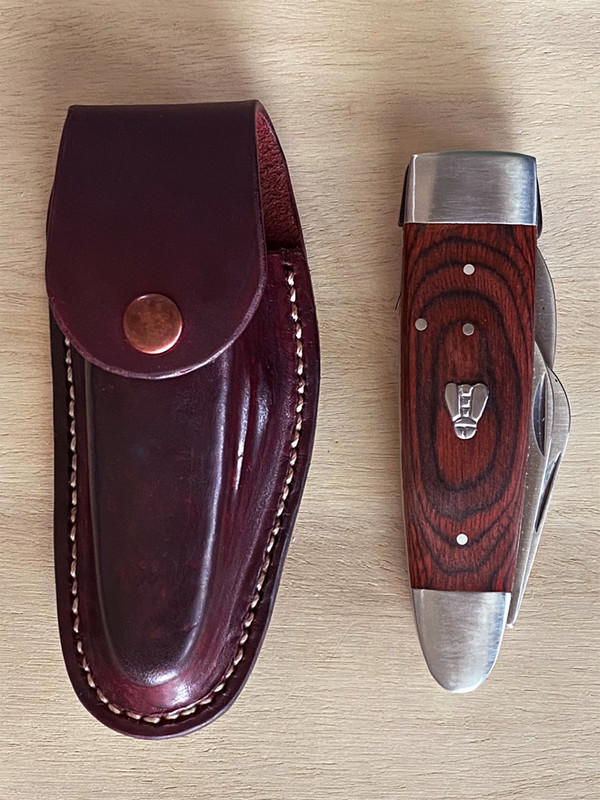
Tools and supplies: I used vegetable tanned 5-6oz cow hide. Horizontally oriented tools, top to bottom: pencil, small brass hammer, larger hammer, utility knife, leather burnishing tool/edge slicker (Tragacanth gum solution not shown). Vertically oriented tools. left to right: skiving knife, edge groover, edge beveller, awl, stitching awl, leather needle (I used two)) with bonded nylon thread (1mm), 2 and 4-prong stitching chisels, rivet/snap tools (punch and anvil), 1 snap (4 parts), rotary leather cutter. Lighter for melting nylon thread ends and Barge cement are not shown.

Wet-molding the leather: the knife was wrapped in plastic wrap, the leather had been soaked for half an hour in warm water. I massaged the leather into shape with my finders and with the help of the burnishing tool. I then stapled the leather to a wooden board and let the leather dry over night.
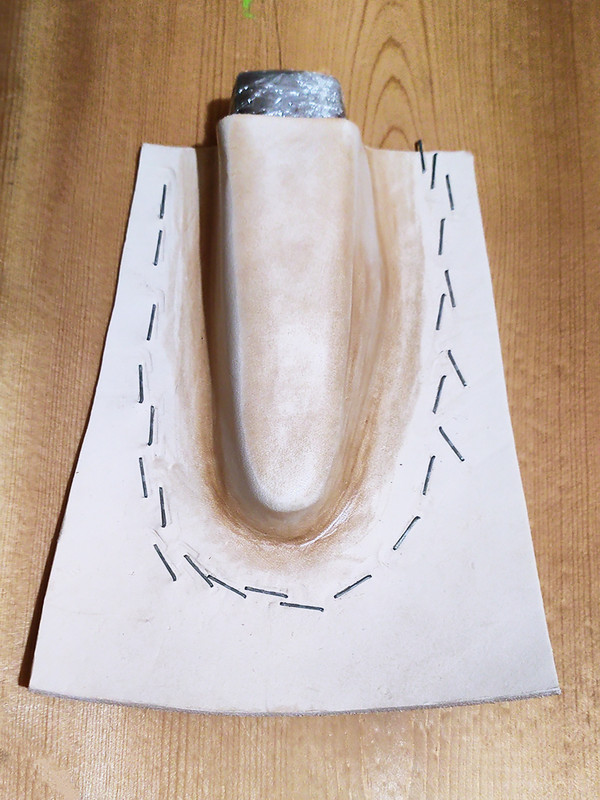
I Trimmed the leather, cut the groove for the stitches, and I beveled the edge. I also cut a circular piece of leather that would later cover the rivet that holds the snap to the case. This piece of leather was thinned towards the edge with the skiving knife for a near flash fit with the case.
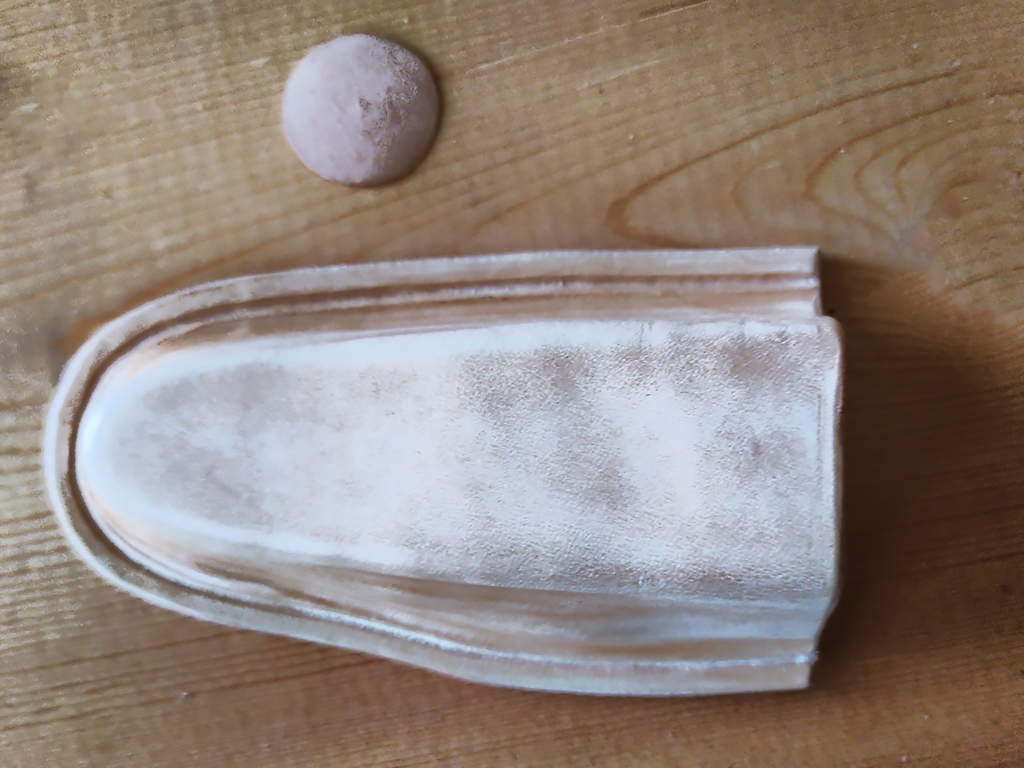
I set the snap bottom half and used the stitching chisel to punch then holes for the thread.

I blued the leather rivet cover on with contact cement. I used the small brass hammer for pounding the leather patch. As cobblers say, "Hammer time!" I also dyed the leather.
I placed the wet-molded leather piece on another peice of leather and traced the base of the knife case. I made sure to leave some meat on the section below the flap. I also used the wet-molded half of the case as a template for punching the holes for the stitches. I also cut a piece of leather as a belt loop. I wet-molded the loop over an old leather belt over night.
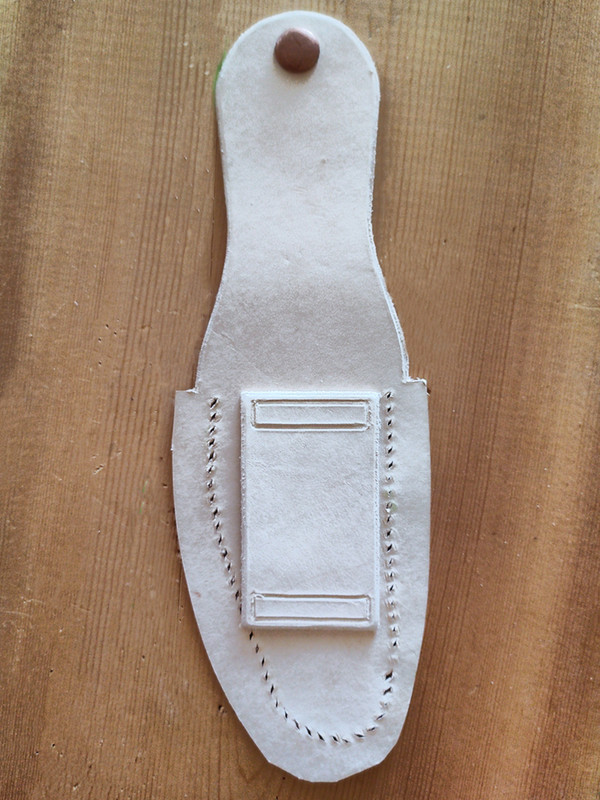
Here are all the leather parts that make up the case. After stitching the case halves together I had to trim the excess leather off the bottom half using the upper half a as a convenient guide. I also dyed, beveled, and slicked the leather edges. The last step was oiling the case with boot oil. On day one I wet-molded the leather (30 minutes). On day two I spent probably an hour finishing all the pieces. On day three I stitched the case together and dyed it again. I spent maybe an hour a day on this. So three hours or so. The leather cost me $20 and the dye was $10, I think. I had the tools and the other supplies. I also oiled the case with boot oil because it will add water resistance. Now, where are those mushrooms?
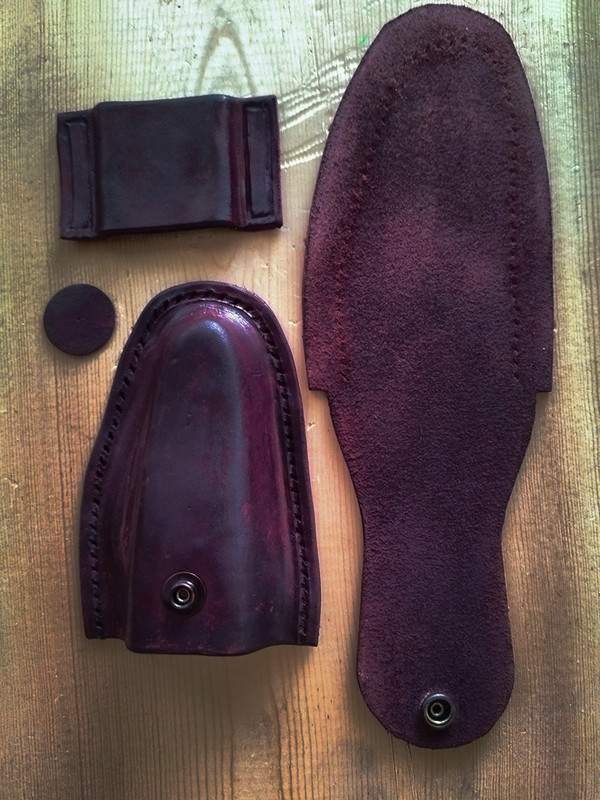

Tools and supplies: I used vegetable tanned 5-6oz cow hide. Horizontally oriented tools, top to bottom: pencil, small brass hammer, larger hammer, utility knife, leather burnishing tool/edge slicker (Tragacanth gum solution not shown). Vertically oriented tools. left to right: skiving knife, edge groover, edge beveller, awl, stitching awl, leather needle (I used two)) with bonded nylon thread (1mm), 2 and 4-prong stitching chisels, rivet/snap tools (punch and anvil), 1 snap (4 parts), rotary leather cutter. Lighter for melting nylon thread ends and Barge cement are not shown.

Wet-molding the leather: the knife was wrapped in plastic wrap, the leather had been soaked for half an hour in warm water. I massaged the leather into shape with my finders and with the help of the burnishing tool. I then stapled the leather to a wooden board and let the leather dry over night.

I Trimmed the leather, cut the groove for the stitches, and I beveled the edge. I also cut a circular piece of leather that would later cover the rivet that holds the snap to the case. This piece of leather was thinned towards the edge with the skiving knife for a near flash fit with the case.

I set the snap bottom half and used the stitching chisel to punch then holes for the thread.

I blued the leather rivet cover on with contact cement. I used the small brass hammer for pounding the leather patch. As cobblers say, "Hammer time!" I also dyed the leather.
I placed the wet-molded leather piece on another peice of leather and traced the base of the knife case. I made sure to leave some meat on the section below the flap. I also used the wet-molded half of the case as a template for punching the holes for the stitches. I also cut a piece of leather as a belt loop. I wet-molded the loop over an old leather belt over night.

Here are all the leather parts that make up the case. After stitching the case halves together I had to trim the excess leather off the bottom half using the upper half a as a convenient guide. I also dyed, beveled, and slicked the leather edges. The last step was oiling the case with boot oil. On day one I wet-molded the leather (30 minutes). On day two I spent probably an hour finishing all the pieces. On day three I stitched the case together and dyed it again. I spent maybe an hour a day on this. So three hours or so. The leather cost me $20 and the dye was $10, I think. I had the tools and the other supplies. I also oiled the case with boot oil because it will add water resistance. Now, where are those mushrooms?

Last edited:
